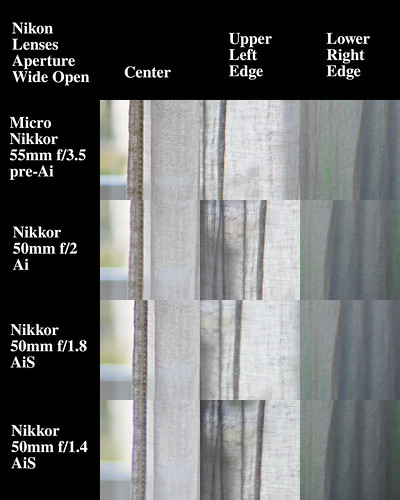Living where I do, I absolutely know much how fortunate I am to live in peace. There is mental space and physical safety to do the things I want, like write these little amount to nothing important blog entries.
Not everyone has this option these days. We receive daily reminders of this fact and it's downright heartbreaking. People are being killed for a man's out-sized sense of power, control, and entitlement. I wish peace for everyone.
And the best of luck to Peter Turnley. He is in the Ukraine right now. What he says about the refugees and the photographs he is making of them fleeing the war zone gives serious pause.
Continuing with the series of posts on field flatness, I'd like to take Yet Another Look at four "standard" focal length lenses.
What brings this on is the arrival of very fine Nikon Nikkor 50mm f/1.4 AiS. Previously I had a "K" version of the lens without realizing it's implementation was different than the early, original Nikkor-S Auto. I only recently tripped over this gap in my understanding when I read Richard Haw's page on the 50mm AiS.
This time I'll look at field flatness using a Sony A7 full frame camera and will avoid comparing anything with a Lens Turbo II focal length reducer on APS-C. I have other things on my mind than further exploring the limits of the focal reducer.
Setup -
- Sony A7 - ISO100, 2 second timer, in-camera levels used to square the whole plot up
- Manfrotto tripod - it's capable of securing an 8x10inch view camera, so it's sturdy enough for this
- Lenses -
- Nikon Micro-Nikkor 55mm f/3.5 pre-Ai
- Nikon Nikkor 50mm f/2 Ai
- Nikon Nikkor 50mm f/1.8 AiS
- Nikon Nikkor 50mm f/1.4 AiS
- Rawtherapee RAW to jpg conversion - Auto-Match function, but nothing further (ie: NO Capture Sharpening) to minimize processing effects
Since the most obvious differences between lenses, in my experience, show up at full aperture, it's the only aperture setting I'll consider here for each lens.
Comparison -
Here is the scene setup. It's just a pair of closed gaze scrims in our apartment. The details are interestingly small, so therefore useful for this kind of "wee look-see."

[As always, click on the image and look at it to 100percent file size to see whatever there is to be seen.]

Comments -
The Nikon Micro-Nikkor 55mm f/3.5 pre-Ai is nice and sharp wide open straight across the field. This macro lens can be used at distances normally optimized for by non-macro optics. It's really a sweet lens.
The Nikon Nikkor 50mm f/2 Ai is fairly sharp wide open across the nicely flat field, though it is clearly not as sharp as the Micro-Nikkor. The behind the point of focus out of focus rendition is "harsh" and looks like "soap bubbles". This is the classic indication that a lens has over-corrected spherical aberration behind the point of focus.
The Nikon Nikkor 50mm f/1.8 AiS is slightly less sharp wide open than the f/2 Ai. We begin to see a certain quality of "softness" at f/1.8. This is attributable to the under-corrected spherical aberration behind the point of focus. The field looks flat.
The Nikon Nikkor 50mm f/1.4 AiS is slightly less sharp wide open than the f/1.8 AiS. Here that quality of "softness" that I mentioned the f/1.8 version having seems to be more pronounced in this f/1.4 lens. And as with all the lenses seen here, the field looks flat.
Not that this comparison is able to show the following, but there is something that I've noticed about over-corrected spherical aberration lenses, and that is that with these older designs they tend to appear "sharper" at the point of focus than their under-corrected spherical aberration designed lenses. The design layout might be identical, but the lens curvature calculations make one implementation behave differently than another.
The three 50mm Nikkor lenses here all derive from the famous double Gauss 6 element 4 group symmetrical design. I mention this because from time to time you will read how such and such a lens might have a "classic" double Gauss design "rendition" or "drawing". I'm not sure what any of that means, since lens designers can choose to control various optical aberrations, including control of coma, astigmatism, and out of focus rendition in any basic optical design (Sonnar, Gauss, Petzval, Tessar, Artar, Dagor, modern computer calculated, etc, etc, etc).
Lens designers can take an exact same design, change the curvatures of the lens' elements and create a lens that has either over-corrected or under-corrected spherical aberration behind the point of focus. Nikkor lenses, historically, have been designed to deliver under-corrected spherical aberration smooth out of focus rendition behind the point of focus. Except when they did not, as in the case of the 50mm f/2 Ai.
I don't think a person can look at a lens design and tell how it will perform. We either need the words of the lens designers to guide us, or have a look for ourselves. Of the three 50mm Nikkors, one is over-corrected spherical aberration behind the point of focus (the 50mm f/2 Ai), and two have under-corrected spherical aberrations (both the 50mm f/1.8 AiS and 50mm f/1.4 AiS).
No comments:
Post a Comment